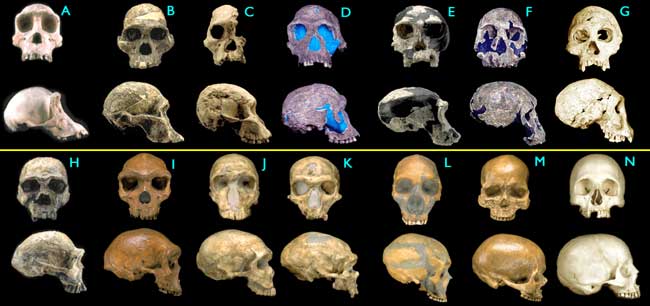As pointed out earlier, there are a number of fossils which show Evolution between humans and our last common ancestor with chimps.
Here we see a number of fossils from the hominins. Names are below:

* (A) Pan troglodytes, chimpanzee, modern
* (B) Australopithecus africanus, STS 5, 2.6 My
* (C) Australopithecus africanus, STS 71, 2.5 My
* (D) Homo habilis, KNM-ER 1813, 1.9 My
* (E) Homo habilis, OH24, 1.8 My
* (F) Homo rudolfensis, KNM-ER 1470, 1.8 My
* (G) Homo erectus, Dmanisi cranium D2700, 1.75 My
* (H) Homo ergaster (early H. erectus), KNM-ER 3733, 1.75 My
* (I) Homo heidelbergensis, "Rhodesia man," 300,000 - 125,000 y
* (J) Homo sapiens neanderthalensis, La Ferrassie 1, 70,000 y
* (K) Homo sapiens neanderthalensis, La Chappelle-aux-Saints, 60,000 y
* (L) Homo sapiens neanderthalensis, Le Moustier, 45,000 y
* (M) Homo sapiens sapiens, Cro-Magnon I, 30,000 y
* (N) Homo sapiens sapiens, modern
Notice how they start to look like us as we go forward in time? The increase in brain size also confirms this.

The picture includes the relevant study as well.
Now we know that all ardipithecines, australopithecines and the ones from the genus homo are bipedal. This can be deduced from the fact that the structure of bone in their femur shows the cancellous bone to be adapted for bipedal walking according to Wolff's Law. Another piece of evidence is the foramen magnum. In all of these fossils, the foramen magnum is more vertical than chimps, highlighting that these are bipedal animals.
For more information on the subject of bipedalism read these papers:
Crompton, R.H., Vereecke, E.E. & Thorpe, S.K.S., 2008, Locomotion and posture from the common hominoid ancestor to fully modern hominins, with special reference
to the last common panin/hominin ancestor, Journal of Anatomy, 212: 501–543
Harcourt-Smith, W.E.H. & Aiello, L.C., 2004, Fossils, feet and the evolution of human bipedal locomotion, Journal of Anatomy: 204, 403-416
Richmond, B.G., Aiello, L.C. & Wood, B.A., 2002, Early Hominin Limb Proportions, Journal of Human Evolution, 43, 529–548
Rodman, P.S. & McHenry, H.M., 1980, Bioenergetics and the Origin of Hominid Bipedalism, American Journal of Physical Anthropology 52:103- 106
Stanford, C.B., 2006, Arboreal Bipedalism in Wild Chimpanzees: Implications
for the Evolution of Hominid Posture and Locomotion, American Journal Of Physical Anthropology 129:225–23
Steudal-Numbers, K.L., 2006, Energetics in Homo erectus and other early hominins: The consequences of increased lower-limb length, Journal of Human Evolution, 51: 445-453
Furthermore, for more papers which show the evolution of humans from a common ancestor with chimps read:
Bastir, M., O’Higgins, P., Rosas, A., 2007, Facial ontogeny in Neanderthals and
modern humans, Proceedings of the Royal Society B; 274, 1125–1132
Cobb, S., 2008, The facial skeleton of the chimpanzee-human last common ancestor, Journal of Anatomy, 212: 469–485
Dean, C., 2006, Tooth microstructure tracks the pace of human life history evolution, Proceedings of the Royal Society B, 22;273(1603):2799-808.
Lewin, 1999, Human Evolution: An Illustrated Introduction, Blackwell Science, UK
Lucas, P.W., Constantino, P.J. & Wood, B., 2008, Inferences regarding the diet of extinct hominins: structural and functional trends in dental and mandibular morphology within the hominin clade, Journal of Anatomy, 212: 486–500
Sherwood, C.C., Subiaul, F. & Zawidzki, T.W., 2008, A natural history of the human mind: tracing evolutionary changes in brain and cognition, Journal of Anatomy, 212: 426–454
Tocheri, M.W., Orr, C.M., Jacofsky, M.C. & Marzke, M.W., 2008, The evolutionary history of the hominin hand since the last common ancestor of Pan and Homo, Journal of Anatomy, 212: 544–562
Wood, B. & Richmond, B.G., 2000, Human Evolution: Taxonomy and palaeobiology, Journal of Anatomy, 196, 19-60
Wood, B. & Lonergan, N., 2008, The hominin fossil record: taxa, grades and clades, Journal of Anatomy, 212: 354–376
Wynn, T., 2002, Archaeology and cognitive evolution, Behavioural and Brain Sciences 25, 3: 389-402
If human evolution is false then we would not see links between these species, which we do as I have many more papers which also detailed the cognitive evolution, showing how society has evolved in co-existence with the physical evolution of humans.
Another conundrum which Evolution solved is Lucy's hand. Chimps and gorillas have a feature in their wrist which allows them to do a form of quadrapedal walking called knuckle walking. It locks the wrist so that it cannot bend back like ours can, evidenced by Smith fractures. Now somewhere, we have lost that trait in our ancestry. Strait, et al, in an anatomical examination of Lucy the Australopithecine, found that these hominins have it whilst later ones such as Homo erectus do not!
Paper is here
This provides proof that this species is not a chimp nor humans as it is bipedal and has a feature only found in other Great Apes excluding ourselves!
Furthermore, if Evolution was false, we would not find this transition in the fossil record. Instead of this gradual increase in brain size, etc, we would see fossils like Homo erectus in the wrong place, a typical "Precambrian Rabbit problem." This shows that the fossil record supports Human Evolution.
Next week, Genetics!
Any papers you want to read? Please leave a message and I'll get back to you.




Evolution is a fact as far as I'm concerned. But what will be the next step? http://www.noisepollution.nl/?p=2193
ReplyDeleteI wrote a two part article on my blog which covers some of my ideas. I would love to hear your thoughts.
Kind regards,
Henk